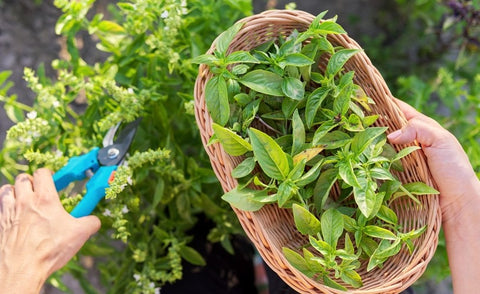Growing Culinary Herbs In A Container Garden
Undoubtedly, the popularity of container gardening is on the increase. Container gardening is a great way for you to grow herbs that you can use not only for cooking but also in other herbal and beauty treatments.
Growing herbs in containers is convenient, less taxing on the body and allows gardener's to move the containers around to suit the outdoor environment or move them indoors when the temperatures drop.
There is such a variety of planting containers available, in various colors, sizes and materials to suit every gardener's needs. Planting containers are lightweight, easy to handle and maintain. Certain herbs may also benefit from self-watering containers while others with soft root systems prefer containers with sufficient drainage.
Herb container gardens are great to have close to your kitchen or outdoor cooking area and they also add an aesthetic and sensory appeal to your garden. The varying heights, growing and flowering times bring color, fragrance and texture to your container garden. Some herbs like rosemary, lavender, garlic and chives also make great pest repellants under your kitchen window.
Whether you are a new gardener or an experienced one, if you are looking to grow a container herb garden, the following article will provide all the information you require to get started.
Selecting The Correct Container To Grow Herbs For Cooking
Before you commence with your herb garden selecting the correct planting container is essential. You should look at your available space before deciding on the size and number of planting containers you require.
The available space is also critical to starting your herb container garden. You can place a wider rectangular container below your kitchen window, or for space restraints you may also consider a vertical container to grow climbing herbs like thyme, mint, and oregano. These herbs are widely used in various cuisines like French, Italian, Moroccan, etc.
You can also grow a broad variety of herbs for cooking in window boxes or railing boxes. Herbs appropriate for growing in these particular containers include basil, chilies, rosemary, etc. Raised bed planter containers are also ideal for growing herbs for cooking.
The container's drainage system is essential when you select the correct container for your herb garden. Plant containers should have sufficient drainage holes beneath the container or you can select a self-water container. Root rot is a common issue when growing herbs for cooking, therefore proper drainage is critical.
Self-watering containers are not ideal for herbs like basil or oregano. These plants have shallow root systems and prefer not to be water logged.
It is good practice to add organic plant material like coconut husks, pebbles, or broken pottery to the container's base to assist with drainage.
You must ensure the container is large enough to accommodate the herb's root system. The general rule is to have containers that are approximately one third the height of the plant and one to half the plant width.
For example, herbs like thyme, oregano or mint have shallow roots and grow close to the ground. They grow approximately twelve inches tall and have a spread of about 8 inches. The ideal container for growing these cooking herbs should approximately be around four inches high by four to six inches wide.
For hardy herbs like rosemary, bay leaf or sage, larger containers are best. You must ensure the container's approximate height is half of the plant's mature height.
Selecting The Correct Herbs For Cooking
You should consider the following questions when you select herbs for your container garden, which are the dishes you cook the most? What herbs do you use regularly?
You can also base your herb garden on your cuisine preferences. For example if you prefer Italian dishes like pastas. Pizzas, etc. you select herbs like Italian basil, fennel, garlic, oregano, parsley, and thyme.
For French cuisine you need herbs like bay leaves, chives, fennel, garlic, marjoram, parsley, rosemary, tarragon, and thyme.
Asian inspired cuisine requires Thai basil, curry leaves, coriander (cilantro), garlic, ginger, lemon grass and don't forget a selection of peppers to add a touch of heat.
Mexican inspired herb gardens will have a selection of chili peppers, cilantro, mint, parsley and thyme.
You can combine several herbs together in one pot. However, you must consider the herb's growing habits when planting in containers. Herbs like mint prefer wet conditions, therefore it is not a good idea to plant mint with herbs like basil or rosemary, which prefer drier conditions.
Planning Your Herb Container Garden
It is vital to plan your herb container garden ahead of the season. For this, you must consider the herb's growing and season times, the plant's water and feeding requirements.
You should add your hardy, herbaceous perennials like rosemary, sage, lavender, thyme or bay leaves as the foundation for your container herb garden. With proper care and maintenance, these evergreen plants can serve you well throughout the season. Their growth is also dependent on their suitability to your climate and region.
Parsley, a biennial, commonly used to flavor soups, stews, and casseroles flourishes in container gardens. However, when temperatures drop you must consider moving them indoors or move them to sheltered space.
You can plan for your summer cooking by adding a selection of annual herbs like basil, cilantro, and summer savory to your plant container garden. You can sow these herbs directly into your planter containers when temperatures start to warm up.

The benefit of growing herbs in containers is that your planting season can begin approximately six weeks before the end of winter. You can sow the herb seeds indoors then move the containers outdoors when it warms up.
Selecting The Ideal Location For Your Herb Garden
Plant containers are ideal for herbs because they are portable. You can move and rearrange them around your patio, deck or balcony to optimize the best growing conditions.
Herb garden containers are great on window sills, doorsteps, along pathways, or under your kitchen window, in areas where you can appreciate the herb's fragrance and beauty.
Some herbs prefer hot conditions while others thrive on cooler or shady areas. The common factor for most herbs is that they receive approximately six to eight hours of sunlight per day. Position your plant container according to the growing requirements of your herbs. Remember when mixing herbs to grow plants with similar growing conditions together.
You should place your herb container close to a water source to avoid lugging a heavy watering can or watering hose around. Alternatively, place a rain barrel to collect rain water or add a drip irrigation line.
Container gardens require more water than regular garden do as herbs in container gardens dry out faster.
If space on your patio, balcony or deck permits, you can utilize that space for more containers of your favorite herb. It is handy to have extra herbs growing especially when you use them for cooking your favorite animal protein or want to stock up on extra pesto.
Plant the herb you use the most of in one plant container, then place this container in the area best suited for growing. When the plant starts to looks sparse, and showing signs of over-use you should move the plant container to a shady area to give it a chance to recover and recuperate.
You can move the second herb container to the location best suited for the plant's growing requirements. As the planting season progresses you can move the two plant containers between the locations.
Select The Best Soil For Your Herb Container Garden
To ensure your herbs are healthy you should always use the best soil in your plant containers. Container soil is less dense than your regular garden soil. It should also contain sufficient organic material for healthy plant growth.
Organic rich soil also has better drainage and moisture control than regular garden soil. If required you can mix some builder's sand to improve the soil's drainage in your plant container.
To create a lighter soil, allowing for better air circulation, with essential nutrients, drainage and moisture retention, you can try the following soil mix in your herb container garden;
- ¼ potting soil
- ¼ landscape or builder's sand
- ¼ vermiculite or peat moss
- ¼ organic compost or manure
Harvesting Your Herbs For Cooking From Your Container Garden

All gardening experts will tell you to ensure new herb growth, you must pinch back and pick your herbs regularly. The harvesting guidelines will help to ensure your herbs flourish and are healthy.
- To harvest leafy, clump herbs like chives, cilantro, parsley and lemon grass you should pick the outer leaves first, working inwards towards the center.
- To encourage further branches and fullness in herbs with upright stems like basil, oregano, mint and rosemary you can clip above the leaves.
- To retain the best flavor of herbs like basil, mint and parsley, clip off the flowers and stalks immediately when they form. You shouldn't discard these flavorful, tasty flowers. They have as much flavor as the leaves and are a great addition to salads, or to garnish your favorite dish.
Pruning Herbs In Container Gardens
When you grow herbs in containers, they have limited growth space, therefore regular pruning helps to keep them in check and encourage additional foliage growth. Additionally, pruning herbs is essential to promote fuller and more productive plants, ensuring that you always have fresh herbs for cooking.
Here are helpful hints to ensure correct pruning of your herbs for cooking;
- Pruning herbs should be done when the plant has reached a height of 6-8 inches, or when it has developed several sets of leaves. This is typically about 4-6 weeks after planting.
- The best time for pruning herbs like bay leaves, lavender, sage, rosemary and thyme is in early spring. If you miss this window, you have another chance after the herb completes its flowering stage.
- To encourage fuller growth, remove the top of the stem just above a set of leaves. This will encourage the plant to branch out and produce more foliage. Ensure you cut at a slight angle to prevent water from pooling on the cut surface.
- To maintain plant health and prevent disease, remove dead flowers, leaves and dry stems.
You can save the seeds from herbs like basil for the following planting season.
Conclusion
Growing herbs you cook with in a container garden is a great way to have fresh, flavorful ingredients at your fingertips all year round. Fresh, organically grown herbs enhance the flavors of any dish you are preparing. Several herbs are low maintenance, easy to grow in container gardens or planter boxes.
With the correct planning, preparation and care, you can successfully grow herbs like basil, mint, parsley, rosemary, and thyme in containers on your balcony, patio, or even indoors. And with the convenience of growing close to your cooking area you can impress and delight your guests and family with the splendors of your herb container garden.
About the Author
Nirvana Parmanand, passionate about gardening, plants, animals and saving our environment through sustainable living. "To plant a garden is to believe in tomorrow," Audrey Hepburn




